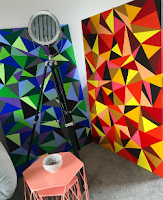My favourite artists were Teesha Moore, Greg Sand and Nikki Farquarson but as my working style has changed over the past few years I have used artists like Sol Lewitt as inspiration, who is a conceptual artist and looks closely at minimalism. Although he works in a wide variety of media, I particularly like his 'wall structures'. I like how his first piece of work consisted of graphite, then crayon, then later in coloured pencils and finally in acrylic paint.
Here are some pictures of my final piece from the foundation course. I produced 2 large canvasses, using lots of layers of acrylic paint and frog tape - I wanted each triangle to be perfect with perfectly straight lines.
I like working randomly and my work doesn't usually have a meaning behind it. I sometimes find myself working backwards. The triangles were positioned randomly and the colour choice was random to some extent, although I tried to divide warm and cold colours, representing different feelings and emotions.
I would say there are 3 main types of visual art : representational art, abstract art and non objective art and I think the media has the biggest effect on the type of work and what category it falls into.
I wouldn't say that my work falls into the 'representational' category as I don't intend to represent actual objects. Although I have looked at realism, impressionism and idealism in the past I'm not very confident in this area. Although representational art probably represents the largest collection of art created, I don't feel like I can relate to this as much as I can with abstract and non objective art. I do like abstract art as I like to exaggerate shapes, lines and colours. I like the idea of transforming one object into something new. My view on the object would often change, giving it a new meaning. However, I personally see my work as non objective art.
For ages I didn't understand the difference between abstract art and non objective art, but then I realised my work doesn't really have a subject from reality. Instead, there is no obvious reference to reality. Jaxon Pollock is the most famous non objective artist I can think of.
He said '' It doesn't make a difference how the paint is put on, as long as something has been said. Technique is just a means of arriving at a statement.''
I agree with this because for me, the most important part of a piece of artwork isn't the process, but the outcome.
A lot of the time my work is just spontaneous but occasionally I would change my ideas when I'm in the middle of a piece. (usually this is part of the development stage) I am happy if my work is aesthetically pleasing, and if my work doesn't look good, or how I intend it to look then I wouldn't consider it finished. This first image was something I did with graph paper and sharpie pens. I like how you achieve a more defined, solid line on paper. I will do a couple more of these using different colours.
Here is an image of a piece of work I did months ago. I tried to push myself out of my comfort zone by not taking projects as literal and by working on cardboard instead, after looking at Martin Creed's exhibition as inspiration.
I plan to do some work with triangles and different shapes, positioning them in the studio environment for the upcoming 'environment' project. Initially, I thought of nature and the outdoors but I've decided I'm going to look at my work in different environments I spend a lot of time in eg Uni, home and work.



















